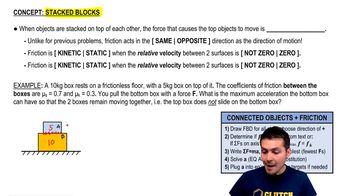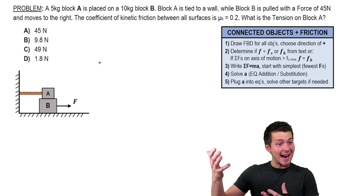Stacked Blocks definitions Flashcards
 Back
BackStacked Blocks definitions
1/15
Terms in this set (15)
- Static FrictionThe force preventing relative motion between two surfaces in contact, acting in the direction of motion.
- Kinetic FrictionThe force opposing relative motion between two surfaces sliding past each other.
- Normal ForceThe perpendicular force exerted by a surface to support the weight of an object resting on it.
- Free Body DiagramA graphical representation showing all the forces acting on an object.
- Coefficient of Static FrictionA dimensionless value representing the ratio of maximum static friction force to the normal force.
- Frictionless FloorA hypothetical surface with no resistance to motion, allowing free movement of objects.
- Maximum AccelerationThe highest acceleration that can be applied without causing relative motion between stacked objects.
- Action-Reaction PairA pair of forces described by Newton's third law, where two objects exert equal and opposite forces on each other.
- Weight ForceThe force due to gravity acting on an object's mass, directed towards the center of the Earth.
- Relative VelocityThe velocity of one object as observed from another object, indicating their motion relative to each other.
- Friction ForceThe force resisting the relative motion of solid surfaces, fluid layers, and material elements sliding against each other.
- Normal Between BlocksThe normal force acting between two stacked blocks, equal to the weight of the top block.
- AccelerationThe rate of change of velocity of an object, influenced by applied forces.
- Connected ObjectsObjects that interact through forces, such as tension or friction, affecting each other's motion.
- Static Friction MaximumThe highest value of static friction before transitioning to kinetic friction, calculated using the normal force and coefficient.


